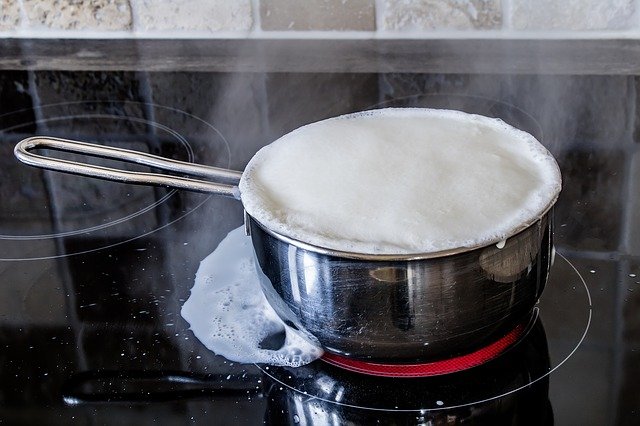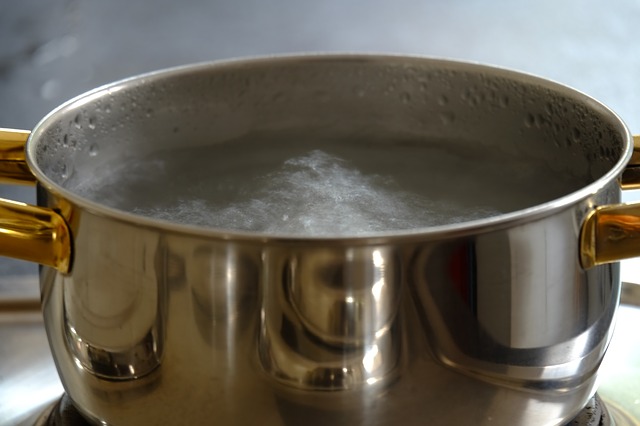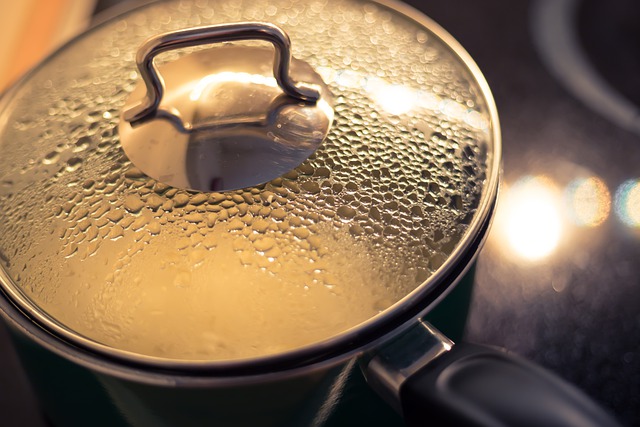In this article, we shall ponder upon the relation between the boiling point and the temperature taking an insight into different conditions.
Just like a melting point, the boiling point of the liquid is a temperature acquired by the liquid due to the application of the heat energy supplied to the liquid to turn its phase from liquid to the gaseous state.
Boiling Point and Temperature Relationship
The relation between the boiling point and temperature of the liquid is given by the Clausius – Clapeyron equation:-

Where T2 is a temperature at which liquid starts boiling
T1 is the boiling point of liquid
R is an ideal gas constant which is equal to 8.314 J/mol K
P is a vapour pressure of a liquid
P0 is a pressure corresponding to T2
ΔHvap is a heat of vaporization of a liquid
The Clausius – Clapeyron equation represents the relation between the temperature and the pressure conditions along the line of phase equilibrium.
We can write the equation for boiling point from the above equation as
T1=1/T2-R ln P/P0 ΔHvap -1
According to which, the boiling point of a liquid is directly dependent on the temperature of a liquid.
The heat of vaporization is the amount of heat energy needed to be supplied to a unit volume of liquid to convert it to the vapour keeping the temperature constant.
Read more on 15+ Example Of Radiant Energy To Thermal Energy: Detailed Explanations.
Example: Calculate the boiling point of the mixture of salt with water kept at atmospheric pressure. The boiling temperature of the mixture is 110 degree Celsius and the vapour pressure is 4.24 atm. The heat of vaporization is 3420 J/g.
Given: T =1100 C
R = 8.314 J/mol K
P =4.24 atm
P0 =1 atm
ΔHvap=3420 J/g
The boiling point of the liquid is given by the relation
TB=1/T – R ln P/P0 ΔHvap-1
Where TB is a boiling point of the solution.
Inserting all values in the above equation, we have,
TB=1/110 – 8.314 ln 4.24/1 3420 -1
=1/110-8.314*1.445 * 3420-1
=9.09-3.51 * 10-3-1
=(5.58 * 10-3 )-1
=103 * 5.58
=179.21 C
This is the boiling of the mixture of salt and water.
The boiling point depends upon the temperature and the pressure and the heat of vaporization of the liquid. At higher altitudes, the time required to boil the water is less than the usual time needed for water to boil, this is because the pressure in the high mountain area is more and hence the water boils at low temperature.
Read more on Critical 20+Examples of Evaporation in Daily Life with Explanations, FAQs.
Boiling Point and Critical Temperature
As the heat energy supplied to the liquid increases, the temperature of the liquid goes high. This heat energy is required for the covalent bonds between the atoms to break apart that are essential to convert the phase of the liquid to gaseous.
At a certain point, the temperature acquired by the liquid is enough to change its phase is called the critical temperature. During this time, the temperature of the liquid does not rise further and the heat energy is released along with the steam generated on boiling the liquid.
For all the liquids the boiling point and the critical temperature varies. This is due to the fact that the element constituency and thus the energy required for the formation of bonds between the atoms varies, hence the variance amount of energy is required to break the bonds between different chemical components.

Image Credit: Pixabay
A simple example that I can give is boiling the milk adding a little water to it. When the temperature reaches 1000 C, the water present in the milk container will start evaporating leaving back the milk, and later after some time, the milk will start boiling.
Read more on 25+ Fluid Friction Examples: Insights and Critical FAQs.
Boiling Point and Saturation Temperature
The saturation temperature is a final temperature above which the temperature of the liquid cannot rise. It is actually the boiling point of the liquid, a temperature at which the phase change of the liquid occurs.
After reaching saturation temperature, the temperature of the liquid does not rise further. This is because the external heat energy supplied to the liquid is given off in the phase changing process. This energy is grasped by the vapours formed and evaporated upward.
You know that the water starts boiling at 100 degrees Celsius, and can further raise the temperature up to 100.52 degrees Celsius. This rise in the boiling point of water is a saturation temperature up to which the water can boil. Likewise, the initial temperature at which the gasoline boils is 35 degrees Celsius or 950 F and the final boiling temperature is 2000C or 3950F.

Image Credit: Pixabay
Beyond the saturation temperature, you will not see a further increase in the boiling temperature of the liquid, as the heat energy will be supplied to the molecules of the liquid which will take this extra energy and will utilize to escape from the liquid in the form of vapours.
Read more on Radiation Heat Transfer Examples: Critical Facts.
Boiling Point and Distillation Temperature
The process of converting the liquid into the vapour form and then getting the vapours back to the liquid state on condensation is called distillation. The constant temperature at which the liquid turns to vapour and back to the liquid is called the distillation temperature.
This is a method used to separate the liquid from the mixture or to remove the impurities from the liquid. As the heat energy acquired by the liquid is sufficient enough, the temperature of the liquid reaches the boiling point. Henceforth, the steam is generated in the form of vapours which are evaporated vertically upward. This evaporated steam is collected in the container maintained at a certain pressure such that these vapours get condensed to turn into the liquid state.

Image Credit: Pixabay
You must have noticed, the steam collected on the lid of the pan while cooking a curry. The water added to the curry is given out in the form of steam once the temperature reaches the boiling point of water. The steam collected on the lid then returns back to the main container by condensing the steam into the water again. This process continues until the temperature of the curry is high enough to supply the heat energy to the water molecules to escape from the curry.
Read more on How is heat transferred by radiation: Exhaustive explanation.
Frequently Asked Questions
What is the change in the boiling point of 150ml the water on adding 25 grams of salt to it at a temperature of 440C?
Suppose the density of the water at temperature 440C is 0.8 g/ml.
Boiling point elevation constant for water is
kb=0.570C
The atomic mass of sodium is 22.99
The atomic mass of chlorine is 35.45
Hence the atomic mass of the NaCl is 22.99+35.45 = 58.44
Hence, the moles of salt added to the boiling water is
Moles of NaCl= 25g*1mole/58.44g
Moles of NaCl= 0.4278 mole
The weight of the water at temperature T=440C is
Density ϱ =M/V
Hence, M= ϱV
M=0.8\times 150=0.12kg
The molality of solute in solvent is
m=moles of solute/mass of solvent
m=0.4278/0.12=3.565 mol/kg
The change in boiling point temperature on adding the salt to the water is given by
Δ T=ikbm
Where i is a Van’t Hoff factor that is defined as the amount of dissociation of solute in the solvent. Here, the solute is a sodium chloride and water is a solvent. Hence, two ions from NaCl will dissociate in the water and will be completely dissolve in the water. Therefore, Van’t Hoff factor here is 2.
Δ T=2*0.51*3.565=3.630C
Hence, the boiling point of the water will be raised to 3.650C.
The boiling point of the mixture will be 104.150C.
Does the presence of impurities in a liquid increase its boiling point?
This is definitely the truth; the impurities present in the liquid increase the boiling temperature.
The heat energy supplied to the liquid is taken up by the impurities present in the liquid thus increasing the temperature required for the liquid to boil.
If you add a solution ‘X’ having a temperature of 280 C to the boiling solution ‘X” reached at a temperature of 650 C, then will the boiling point of the solution will differ?
The boiling point of every solution is always the same and can vary only if the pressure of the liquid is different.
On adding the solution having low heat than compared to the boiling solution, the heat energy will be supplied to the added solution in the container. More amount of heat energy will be required to reach a boiling point, but the boiling point temperature will remain the same.
Also Read:
- Melting point and temperature
- Does dew point increase with temperature
- How to calculate density at different temperatures
- Is temperature an extensive property
- Diffusion and temperature
- Is temperature a physical property
Hi, I’m Akshita Mapari. I have done M.Sc. in Physics. I have worked on projects like Numerical modeling of winds and waves during cyclone, Physics of toys and mechanized thrill machines in amusement park based on Classical Mechanics. I have pursued a course on Arduino and have accomplished some mini projects on Arduino UNO. I always like to explore new zones in the field of science. I personally believe that learning is more enthusiastic when learnt with creativity. Apart from this, I like to read, travel, strumming on guitar, identifying rocks and strata, photography and playing chess.